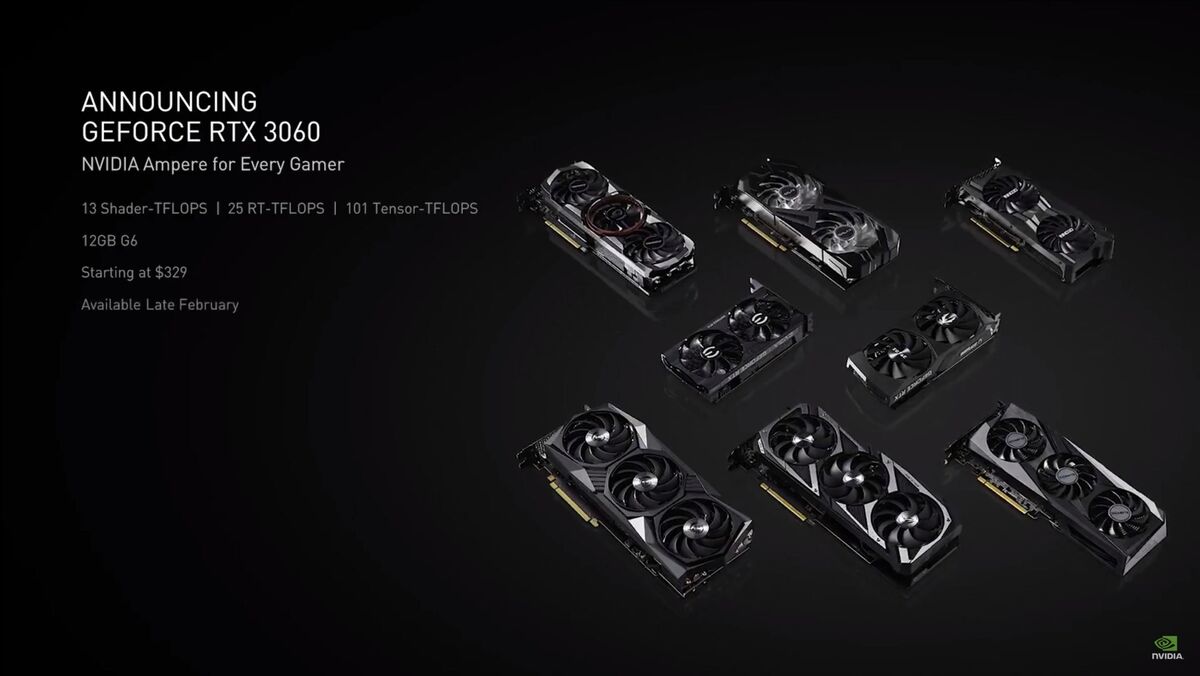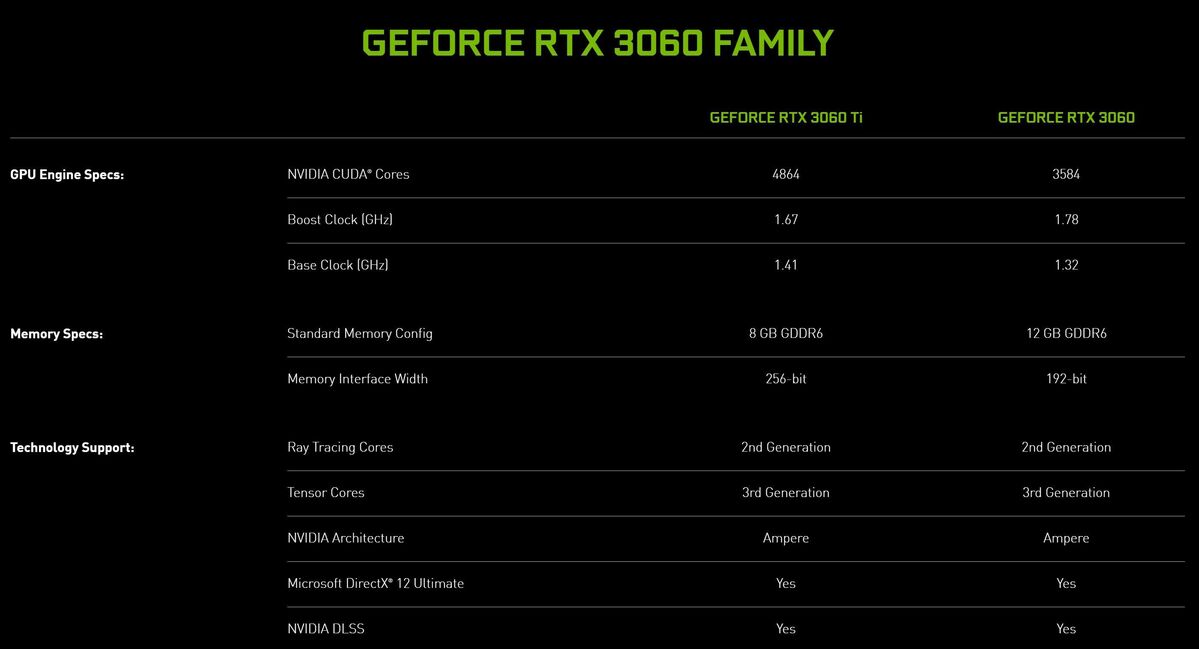[ad_1]
Nvidia’s next-gen “Ampere” GPU architecture finally goes mainstream today with the launch of the $329 GeForce RTX 3060. Normally, the release of Nvidia’s 60-class graphics cards spark a lot of excitement. They tend to be the best-selling cards of any GeForce generation.
But this time around, graphics cards are mired in a months-long shortage driven by a mixture of sky-high demand, logistics woes caused by the pandemic, a cryptocurrency boom that’s driving miners to gobble up GPUs, and some component shortages. It’s a perfect storm, and things are so bad that Nvidia brought the ancient GTX 1050 Ti out of retirement.
So today’s launch of the GeForce RTX 3060 may be the best bet for gamers hoping to get a graphics card at a sane price—if you’re able to beat the purchasing bots, that is. Here are five key things you need to know about the GeForce RTX 3060 before you buy.
1. It goes on sale at noon Eastern time
That’s 9 a.m. Pacific. If you’re hoping to snag a GeForce RTX 3060 today, be sure to have the relevant pages loaded at your favorite etailers, and get ready to slam that F5 button.
If you don’t manage to strike gold, our guide to finding hard-to-get hardware at a fair price can help you out. It’s written for AMD’s similarly scarce Ryzen 5000 CPUs, but the techniques apply for graphics cards too.
2. It will probably cost more than $329
 Nvidia
NvidiaDon’t expect to pay $329 for an RTX 3060 any time soon unless you get lucky on launch day. Nvidia isn’t shipping a Founders Edition version of this GPU, leaving distribution up to custom cards from partners like EVGA, Asus, MSI, etc. If past launches from this generation are any indication, there will be light supply of a handful of RTX 3060s at MSRP, but most of the stock is likely to be pricier, feature-laden models that go for a significant price premium.
We wouldn’t be surprised if retailers jack up prices even further on their end. Graphics cards are hot right now, with even used cards from several years ago selling for more than they cost at launch.
3. It can’t mine Ethereum well
One of the factors limiting graphics card availability might not harm the GeForce RTX 3060. Part of the reason GPUs have been so hard to get is because the price of Ethereum—a cryptocurrency like Bitcoin—has skyrocketed in recent months, and you need consumer graphics cards to “mine” it. Almost every recent graphics card can be profitable mining right now, which isn’t common whatsoever. The RTX 3060 won’t be anywhere near as profitable as its RTX 30-series sibling. Nvidia tweaked the hardware, firmware, and drivers of the RTX 3060 to halve its hashing performance when the graphics card is being used specifically to mine Ethereum, and launched a dedicated “CMP” line of mining graphics cards at the same time. Good.
The RTX 3060 will still perform full-force on lesser known alternative coins, so it may still be desired by some miners. Keeping Ethereum miners away from this card could mean it becomes more easily available though.
4. It has all the memory
 Nvidia
NvidiaPrevious RTX 30-series cards received criticism for their meager memory allotments. The GeForce RTX 3080 only has 10GB of GDDR6X, while the RTX 3060 Ti and 3070 pack 8GB of GDDR6—a worrisome amount when some games already use over 8GB of memory at 1440p resolution. Then AMD launched its Radeon RX 6800-series graphics cards with an ample 16GB of memory. Suddenly, the GeForce RTX 3060 wields a whopping 12GB of memory across a 192-bit bus. That’s overkill for the 1080p and entry-level 1440p gaming this card is intended for, but a lot better than the paltry 6GB this card was probably going to get before AMD started the memory wars.
The RTX 3060 is also the first Nvidia graphics card to support the PCIe Resizable BAR functionality, which first debuted in the Radeon RX 6000-series cards as Smart Access Memory. Resizable BAR grants your CPU full access to your GPU’s memory, which can result in a small performance uplift, though the results vary depending on the game as well as the resolution and visual level you’re playing at.
5. It’s not a big performance upgrade
Our review sample of the GeForce RTX 3060 has been stuck in a FedEx sorting facility on the other side of the country for over a week now, but some other reviewers were able to receive theirs, and they say the GPU is a modest upgrade over what came before. Tom’s Hardware and Gamer’s Nexus say the RTX 3060 performs roughly on par with last generation’s $400 RTX 2060 Super for only slightly less money. The gap widens slightly in games that support ray tracing or Nvidia’s DLSS technology owing to the RTX 3060’s upgraded technology there, but both reviewers aren’t very excited about this release. “Slightly better performance than an RTX 2060 Super at a moderately lower price is the least we could expect, and that’s pretty much what we got,” Jarred Walton says at Tom’s Hardware.
Gamer’s Nexus puts the RTX 3060’s performance on par with the legendary GTX 1080 Ti, so it’s definitely not bad, and will be a great 1080p gaming option. That said, Nvidia is keen to compare the new release against the two-generation-old GTX 1060, but that card cost $250 at launch in 2016—a full $80 less than the retail price that the RTX 3060 isn’t very likely to hit anyway. And the GTX 960 launched at $200. Graphics cards prices have skyrocketed over the last couple of generations and not just when they’re in short supply.
[ad_2]
Source link